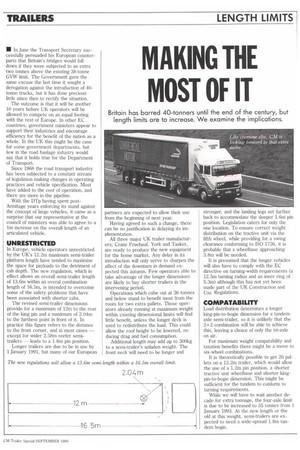AKING THE MOST OF IT
Page 125

If you've noticed an error in this article please click here to report it so we can fix it.
Britain has barred 40-tonners until the end of the century, but length limits are to increase. We examine the implications.
• In June the Transport Secretary successfully persuaded his European counterparts that Britain's bridges would fall down if they were subjected to an extra two tonnes above the existing 38-tonne GVW limit. The Government gave the same excuse the last time it sought a derogation against the introduction of 40tonne trucks, but it has done precious little since then to rectify the situation.
The outcome is that it will be another 10 years before UK operators will be allowed to compete on an equal footing with the rest of Europe. In other EC countries, government ministers appear to support their industries and encourage efficiency for the benefit of the nation as a whole. In the UK this might be the case for some government departments, but few in the road haulage industry would say that it holds true for the Department of Transport.
Since 1968 the road transport industry has been subjected to a constant stream of legislation making changes in operating practices and vehicle specification. Most have added to the cost of operation, and there are more in the pipeline.
With the DTp having spent postArmitage years enforcing its stand against the concept of large vehicles, it came as a surprise that our representative at the council of ministers was able to agree to a lm increase on the overall length of an articulated vehicle.
UNRESTRICTED
In Europe, vehicle operators unrestricted by the UK's 12.2m maximum semi-trailer platform length have tended to maximise the space for payloads to the detriment of cab depth. The new regulation, which in effect allows an overall semi-trailer length of 13.6ni within an overal combination length of 16.5m, is intended to overcome some of the safety problems that have been associated with shorter cabs.
The revised semi-trailer dimensions provide for a maximum of 12m to the rear of the king pin and a maximum of 2.04m to the furthest point in front of it. In practice this figure refers to the distance to the front corner, and in most cases — except for wider 2.58m reefer semitrailers — leads to a 1.6m pin position.
Longer trailers are due to be in use by 1 January 1991, but many of our European partners are expected to allow their use from the beginning of next year.
Having agreed to such a change, there can be no justification in delaying its implementation.
All three major UK trailer manufacturers; Crane Fruehauf, York and Tasker, are ready to produce the new equipment for the home market. Any delay in its introduction will only serve to sharpen the affect of the downturn in demand expected this autumn. Few operators able to take advantage of the longer dimensions are likely to buy shorter trailers in the intervening period.
Operations which cube out at 36 tonnes and below stand to benefit most from the room for two extra pallets. Those operators already running at maximum weight within existing dimensional limits will find little benefit, unless the longer deck is used to redistribute the load. This could allow the roof height to be lowered, reducing drag and fuel consumption.
Additional length may add up to 300kg to a semi-trailer's unladen weight. The front neck will need to be longer and stronger, and the landing legs set further back to accommodate the deeper 1.6m pin position. Legislation caters for only the one location. To ensure correct weight distribution on the tractive unit via the fifth wheel, while providing for a swing clearance conforming to ISO 1726, it is probable that a wheelbase approaching 3.8m will be needed.
It is presumed that the longer vehicles will also have to comply with the EC directive on turning-width requirements (a 12.5m turning radius and an inner ring of 5.3m) although this has not yet been made part of the UK Construction and Use Regulations.
COMPATABILITY
Load distribution determines a longer king-pin-to-bogie dimension for a tandemaxle semi-trailer, so it is unlikely that the 3+2 combination will be able to achieve this, leaving a choice of only the tri-axle on air.
For maximum weight compatability and taxation benefits there might be a move to six-wheel combinations.
It is theoretically possible to get 26 pallets on a 13.2m trailer, which would allow the use of a 1.2m pin position, a shorter tractive unit wheelbase and shorter kingpin-to-bogie dimension. This might be sufficient for the tandem to conform to turning requirements.
While we will have to wait another decade for extra tonnage, the four-axle limit is due to be increased to 35 tonnes from 1 January 1993. At the new length or the old at this weight, semi-trailers are expected to need a wide-spread 1.8m tandem bogie.




























































































































































